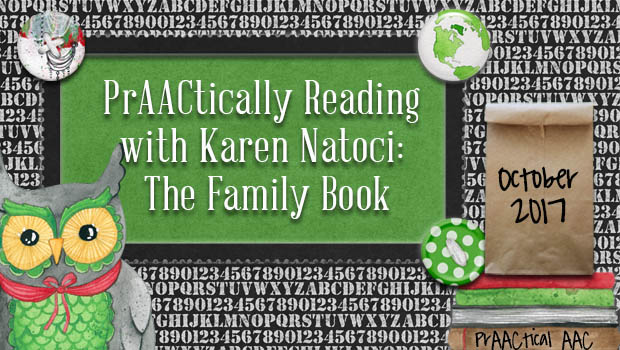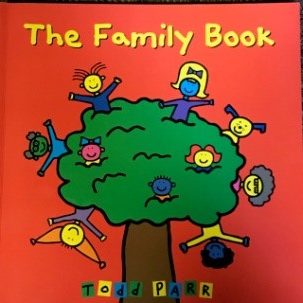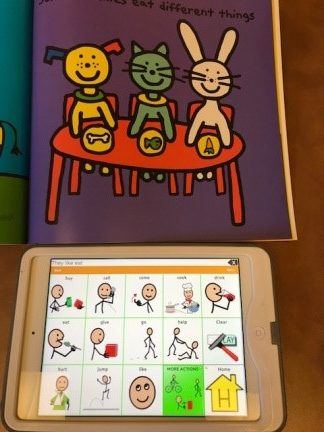PrAACtically Reading with Karen Natoci: The Family Book

 Today, we welcome back SLP Karen Natoci who is resuming her wonderful series on interactive book reading with AAC learners. Karen has supported AAC learners in different capacities throughout her career and is currently an AAC Supervisor with The Speech Pathology Group in Walnut Creek, California.
Today, we welcome back SLP Karen Natoci who is resuming her wonderful series on interactive book reading with AAC learners. Karen has supported AAC learners in different capacities throughout her career and is currently an AAC Supervisor with The Speech Pathology Group in Walnut Creek, California.
You can read more about Karen at the end of her post and explore some of her previous posts here.
PrAACtically Reading
Book: The Family Book Written and Illustrated by Todd Parr (2003); Little, Brown and Company, Hachette Book Group
AAC Competency Areas:
Linguistic:
- Core Vocabulary Focus: big, small, same, different, like, help, my, I,
- Fringe Vocabulary focus: you, me, family, families, mom, dad, sister, brother (their names)
- Math Concept: concept of 1, more than 1, 1 versus 2,
- Actions: eat, noise/quiet, clean/messy
- Syntax: provide co-construction support, model same + one word more
Strategic:
Students will express a variety of communicative modalities to gain attention, and share information so that listeners learn about their families. Students will choose modalities that help the listener understand their message more completely.
It is fun to talk about our families! Talking about the people we live with is sure to elicit lots of smiles and high levels of engagement in the classroom. Families present as a familiar topic and students can use their AAC systems to share!
The Family Book can launch a thousand conversations and opportunities to share personal experiences. This story is the perfect springboard for using new and familiar words with opportunities for communication partners to model and expand!
By the beginning of a school year, we are settling into our school routines. This lesson can work very well with all inclusive and self-contained classrooms. Here’s what to do:
About one month before reading this book:
Send a letter home requesting-
- A photograph with names of: Each member of the family; Pets; Other close family, neighbors, babysitters, friends who come around the house often
- Photo of the front of the house where they live
- Learn about the following:
- Any family favorite meal?
- Any family favorite TV show?
- Which person above lives the closest? Lives the farthest?
- Ask families to send in a photo of
- Family doing something (example: at the zoo)
- A photo of one family member doing something (example: dad cooking, mom ready to go for a jog)
- Other ideas?
Jane Farrell states that “Shared reading allows adults to model vocabulary and language, relating to both the book and to the individual’s life.” This lesson emulates this idea. Now that you have accumulated photos, names and have learned about what families like (and don’t like) to do, each student has something to contribute. Here is a Shared Reading Sequence of how this might work!
Please feel free to modify the following as appropriate! General education activities are readily available for this book by conducting a search (type in the book title, Todd Parr and activities.)
Monday:
- Start by introducing the book you are about to read. Look at the bright and colorful cover. Note the illustration, read the title and author. Ask who wants a closer look. Have the student touch anywhere on the cover and then comment on what they touched (and for those students with emerging pointing ability, as if it was intentional.) If a student is unable to use their hands in this way, note their eye gaze and say (example), “I see you are looking at the girl wearing the bow!”
- Say that this book is about FAMILIES! We all have a family and each family is different. You can talk about how some families are big, some families are small, but we all live with our families. *Be sensitive to living situations and students who may be undergoing particular stresses at home.
- Who lives with their family?
- Who lives in a house? An apartment? On a boat?
- Begin reading the book. Linger after reading each page. Pause with the illustration for all to see. Allow the necessary wait time for students who may wish to respond. You might read one or two pages at a time, up to you! With most pages, you may find that at least one student can say, “I know something about that!” or, “me too!” or, “mine!” When a student makes a comment, we have a moment of sharing where a student may add more.
- Activity– Ask students to draw a picture of their families or print a picture and place it on the tree (similar to The Family Book.) Many students may need the following supports:
- Choose schematic drawings that “look like” each member of the family,
- Dictate exactly how to draw a family (you’re the illustrator and follow directions of the student.)
- Convert the photograph of the family into a line drawing (google apps or websites that allow conversion of photos into cartoons or line drawings.)

Tuesday:
- Shared Writing: Write this sentence in a collective list and ask students to fill in the blank. You will have one line for each student. The aim is for each student to complete the sentence by using their AAC systems and share a photo of someone they live with.
- I live with my _______.
- Activity– Have students work with a staff member (if needed) to begin their own Family Book. The first pages (however many pages are necessary) will have:
- I live with my ____, and use their photo as inspiration to look for a google image that they like and place it on the page. This can be the beginning of writing their own family book.
- Consider the Author’s Chair to have students gather again to share the beginning of their books!
- Allow time for compliments and comments from listeners!
Wednesday:
- Shared Writing (same format as yesterday): Today start with:
- My family likes to_____.
- Activity– Have students work with a staff member (if needed) to begin their own Family Book. The first pages (however many pages are necessary) will have My family likes to ____. And the illustration will be where their photo will be placed. This is the continuation of writing their own family book.
- Consider the Author’s Chair to have students gather again to share the beginning of their books!
- Allow time for compliments and comments from listeners!
Thursday:
- Activity– Today, let’s pick each member of the family and add to the bookmaking.
- Make a page for each member of the family such as:
- Dad likes to_____.
- Mom likes to____.
- Sue likes to___.
- Make a page for each member of the family such as:
- If needed add any additional pages to the “My family likes to___” and add to the first part of the book. There may be 1-3 pages for the “My family likes to__” section.
- Add the appropriate illustration.
- Consider the Author’s Chair to have students gather again to share the beginning of their books!
- Allow time for compliments and comments from listeners!
Friday:
- Re-read the book (or choose students to read all or parts of the book.)
- Shared writing (whole class): My family is_______!
- Activity– Share their own stories
- Activity– Complete the by line by using their alternative pencils.
- Activity– Finally, you might print a few pages for the purposes of creating a organization chart and learn about all of the families!
Use the following table to insert individual targeted goals, objectives or individualized considerations for AAC based communicators in your classroom! I filled out a general idea below:

About the Guest Author
Karen earned both her undergraduate and graduate degrees from the University of Michigan in the area of Psychology, Speech/Hearing Science, and Speech and Language Pathology. Karen has always been drawn to those with complex communication needs. For years, she held a private practice working with the most physically and communicatively challenged survivors of acquired traumatic brain injury and developed a passion in the new field of AAC and AT. Karen spent years at Wing Lake Developmental Center in the Bloomfield Hills School district, and was awarded the Michigan Speech, Language Hearing Association Public School Program of the Year: Sensory Stories in 2006. She was also nominated for the Mclean Yoder Award for Professional Excellence in 2015. She was the course instructor in the area of AAC, Special Education at Wayne State University and earned her status as a Communication Matrix Trainer in 2008. Karen was thrilled to work directly with Dr. Charity Rowland at Oregon Health and Science University on the grant project launching the Communication Matrix, Community of Practice. Karen relocated to the Bay area to spend time at The Bridge School where she was able to immerse herself in their exemplary program before landing in her current role as AAC Supervisor with The Speech Pathology Group in Walnut Creek, California. Karen is busy conducting trainings, demonstrations, and support to increase capacity in the Bay area. She has earned much respect in the AAC Community through her creativity, passion, and teaching. Karen’s motto: Play! Connect! Adjust for vision-hearing-sensory differences by DEGREE and KIND…watch language GROW!
Filed under: Featured Posts, PrAACtical Thinking
This post was written by Carole Zangari

2 Comments
I loved this, and immediately sent it on to my daughter’s SLP. Fantastic ideas, and they mirror what I have been asking to have put on her AC device. If this is her back up voice it must be personalized to her. Thank You for sharing.
Thank you Susan! Would love to hear how it goes!